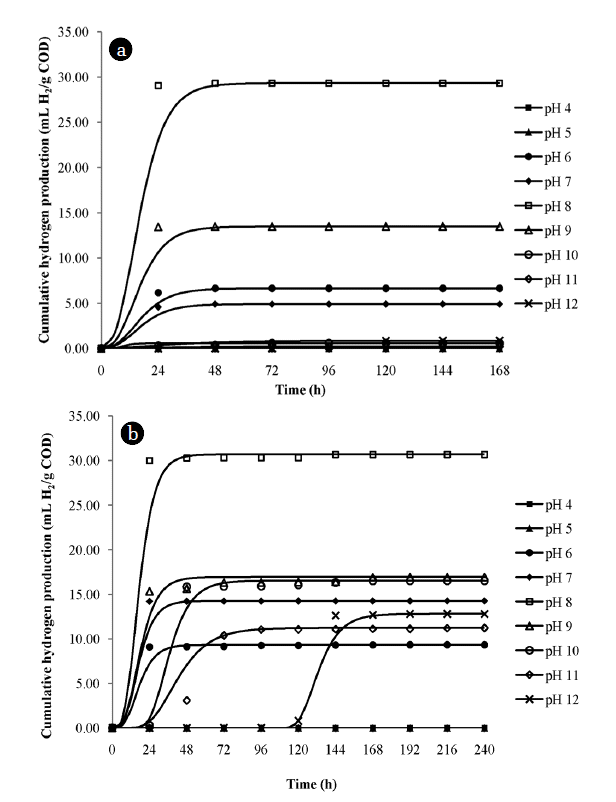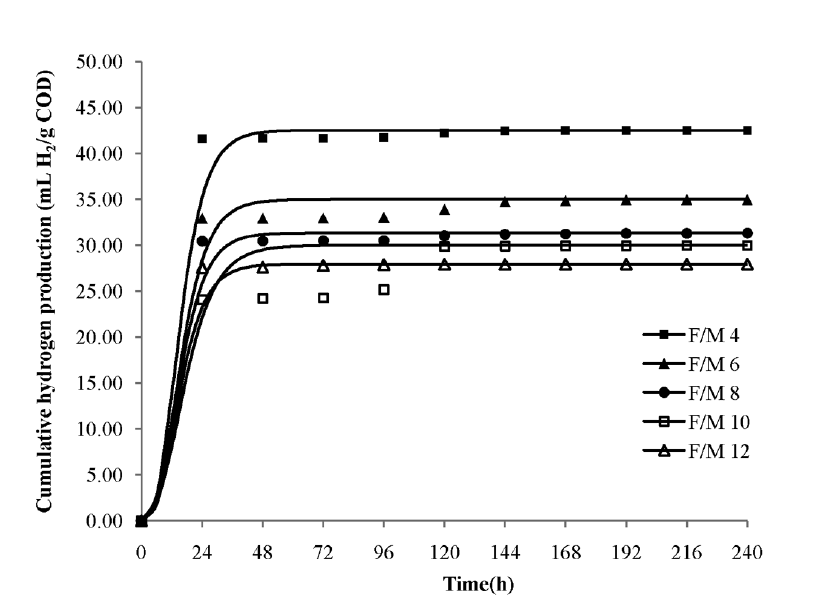1. Introduction
Fossil fuel is a main energy resource in the world (about 80% used in the world). It releases carbon dioxide, when it is used in combustion that causes the major problems as climate change and global warming. These problems directly cause environmental impacts. Moreover, fossil fuel is running out from the earth [1]. In response to the problem stated above, continuous effort has been made in exploration of clean, renewable and alternative energy for a sustainable development. Hydrogen is a clean energy and promising replacement of fossil fuel. Biological hydrogen production (Biohydrogen production), especially a dark-fermentative hydrogen production is a one process, which can produce hydrogen by use less energy than other processes (chemical and electrolysis) and it is a friendly environmental process. However, dark-fermentative hydrogen production depends on optimizing the operating parameters (i.e., pH, F/M ratios, ferrous ion and temperature), which enhance hydrogen production by effect on the bacteria culture [2]. The use of pure culture in dark-fermentation is expensive and technically difficult requiring sterile conditions and strict control [3]. Therefore, mixed culture is considered to generate hydrogen production in dark fermentation and pretreatment was used to inactivate hydrogen consuming bacteria. Restaurant food waste is waste from fundamental human needs, which is the carbohydrate-rich substrate and achieves dual benefits to energy recovery and waste stabilization [4]. Thus, the purpose of this study focused on optimal environmental conditions including initial pH, initial F/M ratio, iron concentration and temperature for enhancing biohydrogen production from food waste that was operated in dark fermentation.
2. Materials and Methods
2.1. Feedstock
Food waste collected from a central cafeteria at Mahidol University (Salaya campus), Thailand, was ground after sorting out animal bones and clamshells. It was mixed with distilled water (food waste:distilled water = 3:1), then sieved with a screen 5 mm (ID). The characteristics of food waste are shown in Table 1.
2.3. Experimental Precedure
Batch reactor was conducted in 250 mL serum bottle with 200 mL working volume. Each reactor consisted of seed sludge concentration 2.5 g VS/L, food waste concentration 25 g COD/L and 10 mL of nutrient solution and then it was filled to the volume mark using distilled water. Nutrient solution contained 200 g/L of NH4HCO3, 100 g/L of KH2PO4, 10 g/L of MgSO4·7H2O, 1.0 g/L of NaCl, 1.0 g/L of Na2MoO4·2H2O, 1.0 g/L of CaCl2·2H2O, 1.5 g/L of MnSO4·7H2O and 0.278 g/L of FeCl2 [6]. Experiment was divided into three steps; the first step was to investigate the influence of initial pH at 4.0, 5.0, 6.0, 7.0, 8.0, 9.0, 10.0, 11.0 and 12.0 on biohydrogen production that was adjusted by either 2 N HCl or 2 N KOH and fixed the initial F/M ratio at 10.0. It was controlled in temperature at mesophilic (35±1°C) and thermophilic (55±1°C) conditions, respectively and the second step was to investigate the influence of initial food to microorganism ratios (F/M) at 4.0, 6.0, 8.0, 10.0, and 12.0 under optimal conditions of initial pH at 8.0 and thermophilic condititon on biohydrogen production and the last step was to investigate the influence of initial iron concentrations at 0, 100, 200, 300, 400 mg FeSO4/L under the optimal conditions; initial pH of 8.0, F/M ratio of 4.0 and thermophilic condition on biohydrogen production. All reactors were purged with nitrogen for 1 min to create an anaerobic condition and then silicone rubber stoppers and screw caps were used to avoid a gas leakage. They were run in triplicate. At designed time, total biogas volume and biogas composition were measured until no biogas production. Liquid sample was analyzed for volatile fatty acid (VFA), chemical oxygen demand (COD) and final pH values.
2.4. Analytical Method and Data Analysis
Total biogas volume was measured by a wetted glass syringe [7] and biogas composition was analyzed by a gas chromatography (GC, Varian Star 3400; USA) equipped with a thermal conductivity detector (TCD) and stainless-steel column packed (Alltech Molesieve 5A 80/100 10′ × 1/8″) with argon gas as carrier gas for hydrogen, nitrogen and methane analysis as helium use as the carrier gas for carbon dioxide analysis [8]. The temperatures of injector, detector, and column were kept at 80°C, 90°C and 50°C, respectively. Hydrogen gas production was calculated from headspace measurement of gas composition and total volume of biogas produced at each time interval by using a following equation (Eq. (1)) [9].
where VH, i and VH, i-1 are cumulative hydrogen gas volumes at the current (i) and previous (i-1) time intervals, VG, i and VG, i-1 are the total gas volumes in the current and previous time interval, CH, i and CH, i-1 are the fraction of hydrogen gas in the headspace of the bottle measured using gas chromatography in the current and previous intervals, and VH is total volume of headspace in the reactor. A modified Gompertz equation [6] (Eq. (2)) was used to calculate cumulative hydrogen data.
where H (mL) is the cumulative hydrogen production P (mL) is the hydrogen production, Rm (mL/h) is the maximum hydrogen production rate, λ (h) is the lag phase time and e=2.71828.
VFA concentration was determined by a gas chromatography/mass spectroscopy (AGILENT 5975C GC; China) equipped with headspace sampler. The operating temperatures of injector and detector were at 250°C and 250°C, respectively and helium was used as a carrier gas at constant flow rate of 2 mL/min. Furthermore, pH liquor was analyzed by pH strip (Shleicher & schuell) and COD analysis was performed according to the standard methods [10].
3. Results and Discussion
3.1. Effect of Initial pH on Biohydrogen Production Under Mesophilic and Thermophilic Conditions
The tendencies of cumulative hydrogen production from food waste at different initial pH values from 4.0 to 12.0 under mesophilic and thermophilic conditions are shown in Fig. 1(a) and 1(b), respectively. A modified Gompertz equation (R2>0.965) adequately described the cumulative hydrogen production. The cumulative hydrogen production increased when initial pH values were increased in the range of 6.0–9.0 and it was negligible at initial pH values of 10.0–12.0. Moreover, hydrogen was not produced in the initial pH values of 4.0–5.0 under both conditions and the final pH value of fermentation was in the range of 4.0–4.5. Some possible reasons for this may be that hydrogen production occurs in acidification stage of metabolic process and the hydrogen-producing bacteria has a high conversion rate of carbohydrate to hydrogen, then the high concentrations of metabolites may cause the pH to drop to such low level [11]. Moreover, acid accumulation in the system causes a sharp drop of the pH, thus inhibiting biohydrogen production. The lowering by pH suggests inactivation of hydrogen producers. The bacteria involved could not sustain its metabolic activity at pH values less than 5.0 and complete inhibition was reported in the pH range of 4.0–5.0 [12]. At mesophilic condition, the maximum hydrogen yield of 29.32 mL H2/g CODadd and the highest butyrate to acetate (B/A) ratio of 1.88 were obtained at initial pH 8.0. On the other hand, the maximum hydrogen yield of 30.69 mL H2/g CODadd and the highest B/A ratio of 1.97 were achieved at initial pH 8.0 under thermophilic condition. Regarding the COD removal efficiency, its thermophilic condition (65.89%) was quite higher than that of mesophilic condition (65.86%). The results were different from previous studies that the highest hydrogen yield under thermophilic condition was observed at initial pH 7.0 [5, 13], while the maximum hydrogen production (47.10 mmol H2/ g CODadd) was observed at initial pH 6.0 under mesophilic condition [14]. Therefore, it could be concluded that key factors of initial pH and temperature affected the biohydrogen production from food waste.
3.2. Effect of Initial F/M Ratio on Biohydrogen Production
As shown in Fig. 2, the initial F/M ratio affected cumulative hydrogen production over 8 h of fermentation under the initial pH 8.0 and thermophlilic condition. A modified Gompertz equation (R2>0.957) adequately described the cumulative hydrogen production. Hydrogen production decreased with increasing F/M ratio, which might be due to interference of VFA distribution and hydrogen-producing bacteria during fermentation [15]. At initial F/M ratio of 4.0, the maximum hydrogen yield was 42.51 mL H2/g CODadd and COD removal efficiency was detected about 65.83%. The major concentrations of VFA were acetate (402.97 mg/L) and butyrate (850.60 mg/L), with butyrate approximately two-fold greater than acetate that was similar to another study [16]. However, this result was different from other studies that the highest hydrogen production was observed at the F/M ratio of 6.0 and 1.5 due to difference of mixed microflora and substrate [16, 17]. Moreover, trends of hydrogen yield and B/A ratio decreased, while final pH value was maintained at 4.50 with increasing F/M ratios (Table 2). Thus, the optimal F/M ratio was an important operating parameter in fermentation for enhancing biohydrogen production [17].
3.3. Effect of initial iron concentration on biohydrogen production
The influence of iron concentration on cumulative hydrogen production under optimal conditions of initial pH 8.0, F/M ratio 4.0 and thermophilic condition is depicted in Fig. 3. A modified Gompertz equation (R2>0.967) adequately described the cumulative hydrogen production. Hydrogen production released after short lag time (8 h) and hydrogen yield increased with time before reaching the maximum. Cumulative hydrogen production increased with increasing the iron concentration at 0 to 200 mg FeSO4/L, while the iron concentrations of 300 and 400 mg FeSO4/L with decreasing the amount hydrogen production. The excess soluble ferrous ion concentration (over 200 mg FeSO4/L) was harmful to the mixed microorganism and was inhibition of hydrogen production in reactor [18]. The highest hydrogen yield was about 44.83 mL H2/g CODadd at the iron concentration of 100 mg FeSO4/L and COD removal efficiency was detected about 66.00%. Moreover, B/A ratio of 2.36 were achieved, while final pH value was maintained at 4.50 (Table 3). The result in certain iron concentration was able to enhance the hydrogen yield by mixed cultures, while much lower or much higher iron concentration than suitable one was not favorable to raise the hydrogen production. However, the electron carrier ferredoxin in hydrogenase plays an important role in the fermentative hydrogen production. Iron is a fundamental component making up the ferredoxin. Only in proper concentration range, iron increases the activity of hydrogenase, which can increase fermentative hydrogen production by mixed cultures in turn, while much lower or much higher ferrous ion concentration than the suitable one can decrease the activity of hydrogenase. It was different from previous studies that were detected the various optimal iron concentrations of 350, 150 and 200 mg FeSO4/L, respectively due to the differences of substrate, initial pH and seed sludge [18–20].
4. Conclusions
In this study, the experimental results of biohydrogen production from food waste operated for 10 days indicated that maximum hydrogen yield of 44.83 mL H2/g COD add was obtained at optimal conditions of initial pH 8.0, initial F/M ratio 4.0 and iron concentration 100 mg FeSO4/L under thermophilic condition. Moreover, major VFA productions of acetate (324.69 mg/L) and butyrate (765.66 mg/L) were observed in reactor and B/A ratio was about 2.36. The COD removal efficiency was detected at 66.00%. Therefore, suitable operating conditions of fermentation from organic waste can be considered as the key factors for enhancing biohydrogen production from food waste.












